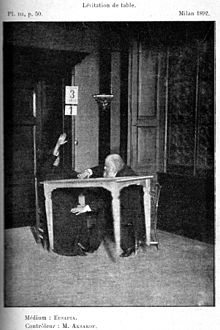



Eusapia Palladino (alternative spelling: Paladino; 21 January 1854 – 16 May 1918) was an Italian Spiritualist physical medium.[1][2] She claimed extraordinary powers such as the ability to levitate tables, communicate with the dead through her spirit guide John King, and to produce other supernatural phenomena.
She convinced many persons of her powers, but was caught in deceptive trickery throughout her career.[3][4][5][6] Magicians, including Harry Houdini, and skeptics who evaluated her claims concluded that none of her phenomena were genuine and that she was a clever trickster.[7][8][9][10]
Her Warsaw séances at the turn of 1893–94 inspired several colorful scenes in the historical novel Pharaoh, which Bolesław Prus began writing in 1894.
- ^ Georgess McHargue. (1972). Facts, Frauds, and Phantasms: A Survey of the Spiritualist Movement. Doubleday. p. 136. ISBN 978-0385053051
- ^ Rosemary Ellen Guiley. (1994). The Guinness Encyclopedia of Ghosts and Spirits. Guinness Publishing. p. 242. ISBN 978-0851127484
- ^ Joseph Jastrow. (1918). The Psychology of Conviction. Houghton Mifflin Company. pp. 101–127:
The 1918 chapter was a re-print of an article that Jastrow had written in 1910: Jastrow, Joseph, "The Case of Paladino (sic)", The American Review of Reviews, Vol.42, No.1, (July 1910), pp.74—84. - ^ Walter Mann. (1919). The Follies and Frauds of Spiritualism. Rationalist Association. London: Watts & Co. pp. 115–130
- ^ Ernest Hilgard. (1967). Introduction to Psychology. Harcourt, Brace and Company. p. 243. ISBN 978-0155436381 "Eusapia Palladino was a medium who was able to make a table move and produce other effects, such as tapping sounds, by the aid of a "spirit" called John King. Investigated repeatedly between 1893 and 1910, she convinced many distinguished scientists of her powers, including the distinguished Italian criminologist Lombroso and the British physicist Sir Oliver Lodge. She was caught in deceptive trickery as early as 1895, and the results were published. Yet believers continued to support her genuineness, as some do today, even though in an American investigation in 1910, her trickery was abundantly exposed. Two investigators, dressed in black, crawled under the table unobserved and were able to see exactly how she used her foot to create the 'supernatural' phenomena."
- ^ Milbourne Christopher. (1971). ESP, Seers & Psychics. Crowell. pp. 188–204. ISBN 978-0690268157
- ^ Harry Houdini. (2011, originally published in 1924). A Magician Among the Spirits. Cambridge University Press. pp. 50–65. ISBN 978-1108027489
- ^ Joseph Rinn. (1950). Sixty Years of Psychical Research: Houdini and I Among the Spiritualists. Truth Seeker Company. pp. 272–356
- ^ C. E. M. Hansel. (1980). ESP and Parapsychology: A Critical Re-Evaluation. Prometheus Books. pp. 58–64. ISBN 978-0879751197
- ^ Massimo Polidoro. (2003). Secrets of the Psychics: Investigating Paranormal Claims. Prometheus Books. pp. 62–96. ISBN 978-1591020868